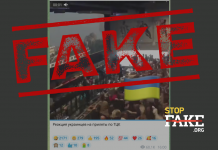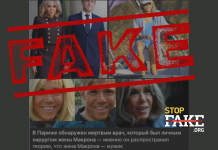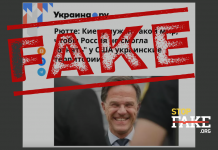Vladimir Chyzhov, Russia’s Ambassador to the European Union was recently interviewed by the EUractiv publication. In the interview Chyzhov devotes a great deal of time to nuclear disarmament and the fate of the INF treaty; he also talks about the European Parliament elections, Ukraine, the MH17 investigation and Russian energy projects.
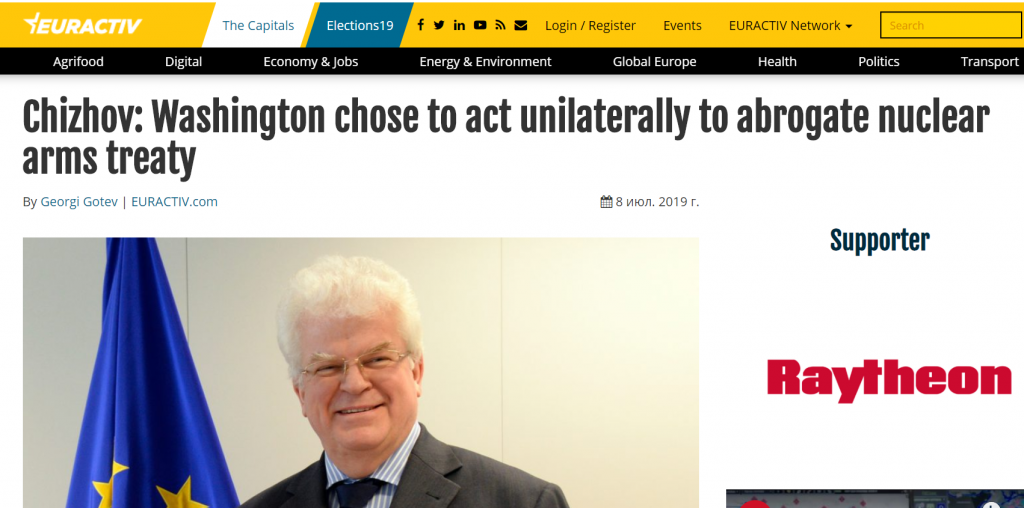
StopFake analyzed Chyzhov’s claims particularly about the INF treaty and MH17 and discovered some inaccuracies, distortions and outright lies.
Nuclear weapons and the INF Treaty

Vladimir Chyzhov claims that the current US administration chose to kill the INF treaty and has therefore sets a very dangerous precedent. “If there are two parties to a treaty, there may be mutual recriminations. That was the case. We had ample evidence of US violations. But instead of sitting together and discussing a possible way out Washington chose to act unilaterally and abrogate the Treaty,” Chyzhov said.

The Intermediate-Range Nuclear Forces Treaty (INF) was signed by US President Ronald Reagan and Soviet leader Mikhail Gorbachev in 1987. It banned missiles with ranges between 500 and 5,500 km (310-3,400 miles).
Since 2014, the United States has said that Russia has violated the INF Treaty, having in its arsenal a land-based cruise missile with a range of more than 500 km, the 9M729 missile (SSC-8 according to NATO classification). American intelligence agencies provided evidence of these violations to their NATO partners, according to which, from 2008 to 2011 Russia tested a banned missile at the Kapustin Yar test site.
While Russia admits that it has 9M729 missiles in its arsenal, it claims that their range does not exceed 500 km and therefore these missiles do not fall under the terms of the INF treaty. In January 2019 the Russian Defense Ministry held a briefing for foreign military attaches and showed them the alleged missiles in question. However, according to military experts, the rockets exhibited were in no way similar to the 9M729 missile.
Russia in turn accuses the US of violating the INF treaty by including the MK-41 vertical launching system in the European missile defense system which supposedly can be used to deploy cruise missiles. Russia also claims that the US uses target missiles similar to short and medium range land missiles and is increasing the production and use of combat drones.
The evidence US intelligence agencies provided to their NATO colleagues was so impressive and incontrovertible that Alliance members openly spoke out about Russia’s INF treaty violations.
It is clear to us that Russia has violated this treaty… The important thing is to keep the window for dialogue open” German chancellor Angela Merkel said in February of this year speaking at the Davos World Economic Forum.
“The consequences are enormous … but let me start by ascertaining that it was Russia who violated the treaty; a treaty does not exist if only one party complies …” Polish Minister of Foreign Affairs Jacek Czaputovicz said, speaking at the last Munich Security Conference.
The Romanian Foreign Ministry also called Russia out for violating the INF treaty. In a statement the ministry said: “Any attempt by the Russian Federation to deny this fact is blatant misinformation and an attempt to divert attention from a real violation by the Russian state of the INF Treaty.”
The Downing of MH17

Russia’s political discourse about the crash Malaysia Airlines Flight 17 (MH17) en route from Amsterdam to Kuala Lumpur which was shot down on 17 July 2014 while flying over eastern Ukraine, killing all 283 passengers and 15 crew on board can be summarized in several points:
- Russia conscientiously helped the crash investigation effort but was not included in the Joint Investigation Team.
- The Joint Investigation Team used dubious sources of information ignoring all evidence provided by the Russian side.
- Ukraine should at least be held responsible for not closing its air space.
- Russia has strong evidence that MH17 was shot down by a Ukrainian missile.
All of these hypotheses have been propagated by Russia’s Foreign Ministry, particularly after the Dutch government said that Russia was responsible for the downing of MH17.Vladimir Chyzhov repeats all of these claims in the Euractiv interview.
“We have been open to cooperation from the first day,
but the composition of the Joint Investigative Committee raises
questions. Russia offered to participate, but we were rejected.”
Chyzhov claims that Russia has been open to cooperation from the first day. Russia offered to participate in the investigation and was rejected, he says and adds that Russia has questions as to the composition of the investigation team.
When the Joint Investigation Team (JIT) was formed it was made up of five countries, Malaysia, the Netherlands, Belgium, Australia and Ukraine. Russia refused to be part of the joint team saying it was pursuing its own investigation.
In September 2017 two months after the MH17 crash, Russian Foreign Minister Sergey Lavrov said that a Russian representative was taking part in the work of the Joint Investigation Team. However, Lavrov also simultaneously criticized the work of the team saying there was “neither transparency nor accountability” in the work of the international investigators.
During the first year of investigations conducted by the Joint Investigation Team Russia consistently criticized the work of the team: “The Russian side has many serious questions regarding the technical and criminal investigations coordinated by the Dutch authorities which give reason to doubt that these investigations comply with (UN Security Council Resolution 2166 and International Civil Aviation Organization) criteria and are sufficiently transparent.
This investigation failed to take into consideration
whatever information Russia provided.
“… we were prepared to cooperate, we sent all the data, even
staged experiments with a similar missile and similar fuselage,
and provided evidence that the shrapnel holes in theMH17
plane looked like having been pierced by a Ukrainian missile.”
Chyzhov further claims that the investigation completely ignored information that Russia provided. He says Russia conducted its own reenactments of the crash and has come to the conclusion that the holes in the body of the MH17 aircraft they were “pierced by a Ukrainian missile”.
All of the information provided by Russia was carefully checked by the Joint Investigation Team . Russia conducted its “investigation” at the Almaz Antey state owned weapons production company and concluded that MH17 was shot down by a missile launched from the Ukrainian village Zaroshchenske.
The JIT said it would verify the points presented by Russia as soon as the Russian Federation submitted documents backing up its claims.
Russia’s version about Ukraine being involved in the MH17 crash was based on suspicious radar data and the stories of two eyewitnesses, one who allegedly saw Ukrainian military equipment in a field near the Zaroshchenske settlement, the other witness allegedly saw the plane crashing on radar. The radar data that Russia provided in 2016 did not match radar data from 2014, the year of the crash. Dutch investigators have doubts about the authenticity of these images.
The independent investigative journalism website Bellingcat, using evidence from open sources, has shown that Russia’s version of events concerning MH17 is false.
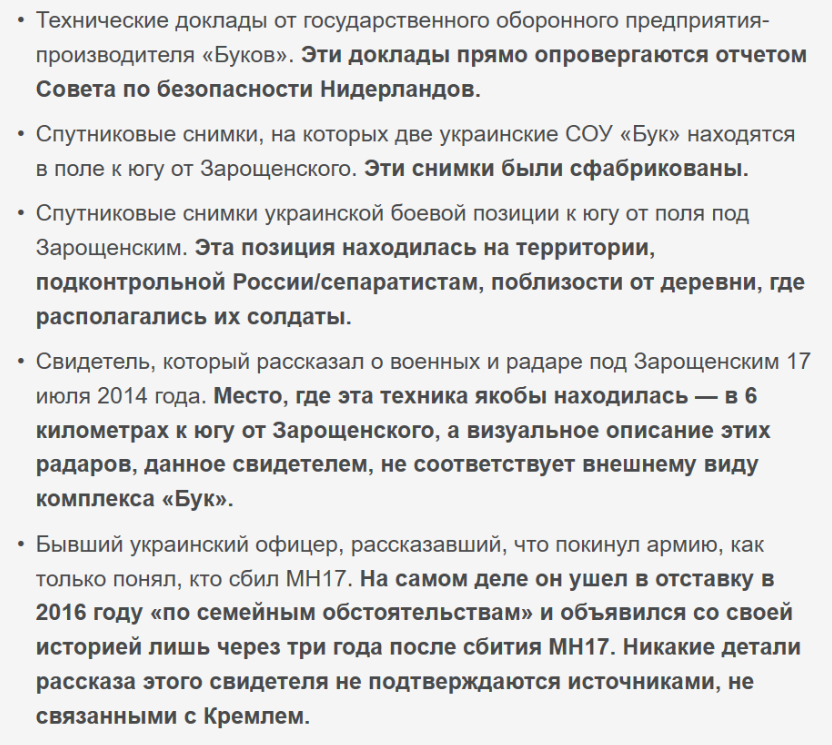
Russian evidence supporting the theory of a missile launch from Zaroshchenke
Technical reports from the state owned Bukov defense company. These reports were directly refuted by a Netherlands Security Council report.
Satellite images in which two Ukrainian self-propelled BUK missiles are in a field south of Zaroshchenske. These images were fabricated.
Satellite images of Ukrainian combat positions south of the Zaroshchenske field. This position was actually located in Russian separatist controlled territory near a village where Russian soldiers were deployed.
A witness who said he saw military equipment and a radar near Zaroshchenske village on July 17, 2014. The place where this equipment was allegedly located is 6 kilometers south of Zaroshchenske and the visual descriptions the witness provided are completely different from a BUK complex.
A former Ukrainian officer who said that he left the army as soon as he realized who actually shot down MH17. In fact this officer resigned in 2016 for family reasons and made his story public only three years after the downing of MH17. No details of this witness’ story were ever corroborated by sources unrelated to the Kremlin.
Since 2014 JIT investigators have consistently not received any and all information they have requested from Russia. In August 2018 Russia notified the JIT in writing not to file additional requests for relevant information held by the Russian authorities.
The evolution of Russia’s many different versions of the MH1 crash can be found here.
As a result of the JIT investigation, it was possible to establish that the BUK missile belongs to the 53rd Russian Air Defense Brigade based in Kursk.
Ukrainian Deputy Foreign Minister Olena Zerkal wrote on Facebook that Russia did everything to delay and confuse the MH17 investigation. “All this time the country responsible for the tragedy denied its involvement, obstructed justice against the perpetrators and did everything to avoid responsibility” Zerkal wrote.

In trying to place the blame for the crash on Ukraine, Chyzhov admits that MH17 was brought down by a BUK missile, but he claims it was “a Soviet-built previous generation of BUK which is not in service in the Russian army anymore” and although produced in 1986, this model is still used by the Ukrainian army.
Russia’s so-called investigation into the MH17 crash conducted by the Almaz Antey government owned arms manufacturing company concluded that MH17 was shot down by a Ukrainian BUK missile fired from the Zaroshchenske area. These findings were completely refuted both by the Joint Investigation Team and Bellingcat, whose investigators were able to establish that the BUK used to bring down the Malaysian plane in fact belonged to the Russian 53rd Air Defense Brigade. They also reconstructed the BUK’s transit route through the Ukrainian-Russian border to the launch site.
Novaya Gazeta conducted its own investigation and interviewed the residents of Zaroshchenske, who told the newspaper that on July 17, 2014 there were no Ukrainian military in the settlement itself and no Ukrainian military equipment in the surrounding areas. There were no traces of heavy equipment having moved in the fields. In July 2014 Zarozhchenske was a Donetsk People’s Republic checkpoint.

In December 2014 Armament Research Services (ARES) , the specialist technical intelligence consultancy which offers expertise and analysis to government and non-government entities in the arms and munitions field analyzed more than 100 types of weapons and 60 types of ammunition and concluded that most of the weapons, ammunition and military vehicles in occupied eastern Ukraine are of Russian origin. Russia continues to supply the Donetsk and Luhansk People’s Republic militants with equipment even today.
Immediately after the crash Russian began accusing Ukraine of not closing the air space over the war zone.
During a visit to the UN in 2015, Ukraine’s Foreign Minister Pavlo Klimkin said “At that time we did not realize that such a threat existed, that Russia could send a high precision missile system to Donbas to shoot down planes”.
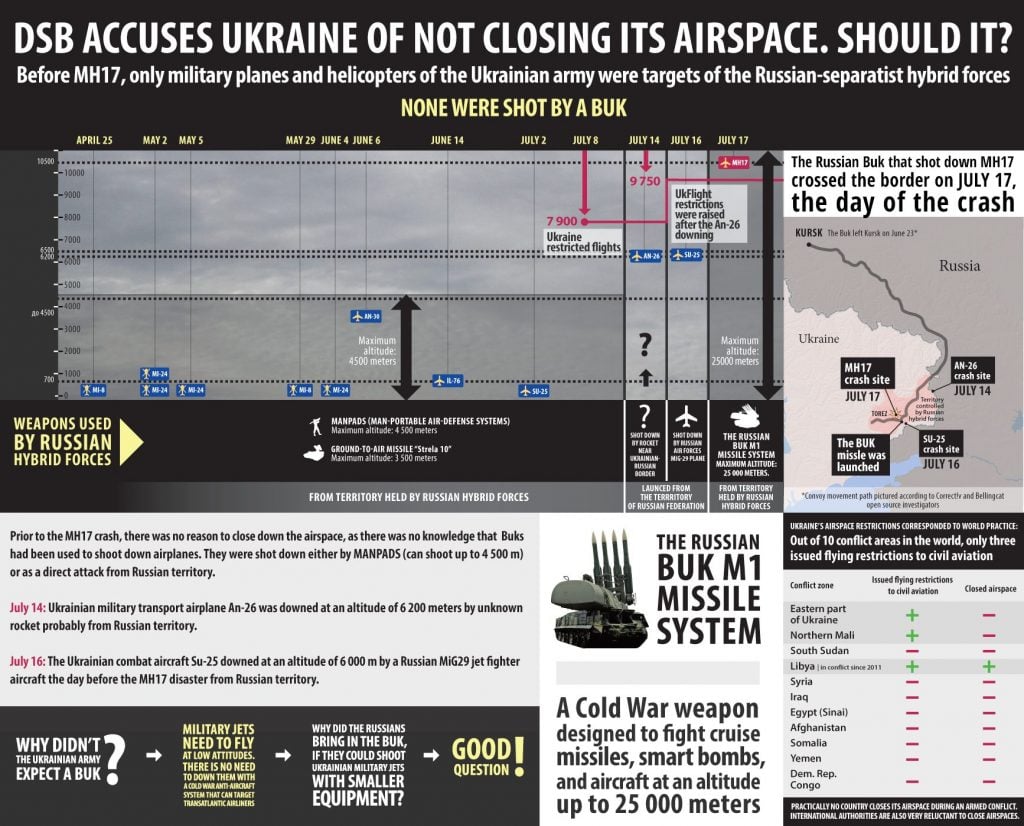
Until the downing of MH17 there was no reason to expect any danger to aircraft flying at an altitude of 10,000 meters. At that point Ukraine’s military had not recorded the presence of a weapons system that posed a danger to passenger aircraft.
Ukrainian military aircraft were shot down on the eve of July 14 and 16 while flying at an altitude of less than 10,000 meters. Ukraine had only three days to assess the situation as MH17 was shot down only three days later, there was no reason to believe that passenger aircraft would be used as targets by the Russian backed militants.
Chyzhov announced that the four men who were named by the JIT as responsible for the downing of MH17 “have nothing to do with operating missiles, they cannot know how to push the button”.
In fact they have everything to do with the missile attack on MH17.
The Joint Investigative Team confirmed the identity of four militants who played a key role in deploying the BUK missile launcher from Russia, moving it to the launch site and returning it back to Russia after MH17 was shot down. International arrest warrants were issued against four separatist commanders of the self-proclaimed Donetsk People’s Republic, Ukrainian citizen Leonid Kharchenko and Russian nationals Sergei Dubinsky, Oleg Pulatov and Igor Girkin. Bellingcat has published an extensive investigation in which they demonstrate the involvement of the four in the destruction of the Malaysian airliner. The full investigation is available here.
JIT investigators have said that they are also examining the involvement of “several dozen individuals” in the tragedy, therefore it is to be expected that these are not the last indictments. The trial is scheduled to begin in March 2020.



